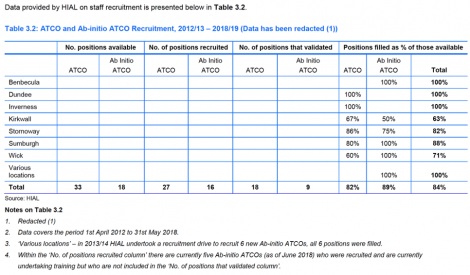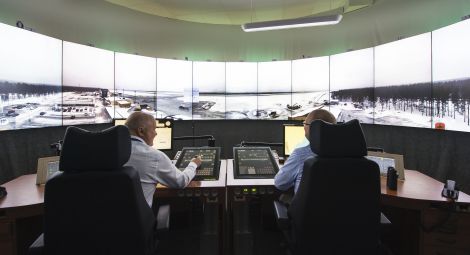Viewpoint / HIAL’s air traffic controller recruitment: a view from within
A ‘perceived’ recruitment crisis for air traffic controllers at island airports is being used by airport operator HIAL to further its ATC centralisation plans, writes Peter Henderson who has been working at Kirkwall airport’s control tower for 18 years
Having read the recent Shetland News report Air traffic control impact assessment a ‘cursory process’, SIC says, I feel compelled to speak out.
To date, the HIAL corporate voice has dominated the debate over the centralisation of all air traffic control to Inverness. Air traffic controllers within HIAL are not permitted to make their views known as HIAL company policy forbids them doing so via the use of the press or social media. The penalty for ignoring this policy is disciplinary action or dismissal.
No longer working for HIAL means I can speak out.
The Shetland News article points out that the main rationale for the remote towers project and centralisation of all air traffic control to Inverness is to address staff recruitment and retention. In this opinion piece I will address only recruitment and retention and why this has been perceived as a problem by HIAL corporate management.
I will also make it known that HIAL have solid and incontrovertible proof that they already have a tested and lasting solution to their alleged problems that works but, for whatever reason, they no longer want to use.
My views on the HIAL remote towers project and ATC centralisation can wait for another time.
The primary method adopted by HIAL to recruit air traffic controllers has always been dysfunctional and driven by a desire to fill vacancies as quickly and cheaply as possible. Solutions offered by staff members are ignored.
HIAL’s preferred method is to recruit either fully qualified licensed air traffic controllers or part-qualified air traffic controllers. Advertising in aviation publications or on the HIAL website is used as those already within the professional aviation community know where the jobs are advertised and what they involve.
A fully licensed controller only needs specific training for the airfield where they are to permanently work so little financial investment is needed.
Become a supporter of Shetland News
Partially trained controllers will have already passed stringent assessment, selection and medical requirements. This cost burden was met by their previous employer. There is already a reduced risk of them failing the costly residential training course and lengthy on-the-job training further needed to gain a full license.
This preferred method of recruitment seems to offer significant savings to HIAL in the short term but is, in fact, a poor return on investment.
The secondary and rarer course of action used by HIAL is to advertise in the local press within the areas served by HIAL as well as on the HIAL website and in aviation publications. They have called for applications from people with no aviation knowledge or ATC experience and offered to train them as controllers from scratch.
Training from scratch is seen by HIAL as hugely expensive and time consuming. High medical requirements are needed. Aptitude tests are needed to ensure applicants possess the rare combination of specific personality skills vital to become an air traffic controllers. You either have these skills or you don’t, they cannot be gained as a result of training. Even having these skills is no guarantee that they will pass the training and meet the high standards set to pass Civil Aviation Authority (CAA) validation to become a fully qualified licensed controller.
HIAL seldom takes this route as there is the belief that once trained, the fully qualified controller they have paid for will almost immediately disappear to a more highly paid job elsewhere.
HIAL also believe, wrongly, that recruiting from within the islands holds little chance of attracting people capable of having the skills needed.
HIAL have for many years followed this flawed pattern of recruitment and here is the proof.
Fully licensed controllers recruited by HIAL mostly stay for a few years before leaving. Likewise, the partially qualified controllers let HIAL pay for the rest of their training, work for a few years to gain experience, then mostly leave. They have no ties to the Highlands and Islands so don’t remain. This is a repeating pattern.
In 2015 HIAL went to Sweden to recruit six trainee controllers directly from a training college there. These controllers then had to attend a costly residential training course in the UK in order to gain the procedural control rating they needed to work for HIAL.
Having gained that qualification, they were still classed by the CAA as trainees. They still had to undergo full length on-the-job training at the airfields they were to work at in order to gain the training experience required. Finally, they successfully passed their final CAA validation examination and became fully qualified.
Every single one of them was exactly what we were looking for as controllers, was well liked and fitted into their airport ATC teams perfectly. Every single one of them left to take up jobs in Sweden by the end of 2018.
I can honestly say that the controller from Sweden who worked at Kirkwall is sorely missed and it was a sad day for us all when he departed for home, as had so many who were recruited that way.
In order to replace the departing Swedish controllers, HIAL this time chose to launch a high-profile recruitment drive.
HIAL ATC recruitment had its own dedicated website atc.hial.co.uk/the jobs (the link is now unavailable). There was a video highlighting the attractions of life in the Highlands and Islands, a drop-in session was held in a luxury hotel where interested candidates could find out more about working for HIAL. In short, it was the most professional attempt to date by HIAL to recruit controllers.
Strangely, it was aimed solely at recent graduates from an aviation college in Finland.
More strangely, if you went to the careers section of HIAL’s website there was no mention of recruitment from Finland and no link to the HIAL ATC recruitment website. It seemed to be a secret we weren’t meant to know about.
Only three were recruited from Finland as a result of HIAL’s efforts. They are now undergoing the same training regime as their predecessors. How long they will choose to stay remains to be seen. I suspect the previous pattern will repeat itself.
Despite the high turnover, a number of controllers have chosen to stay and have rooted themselves in their adopted communities. They are here for good and have no wish to leave.
So, what is the tried and tested way HIAL have of recruiting and retaining staff that I referred to at the beginning of this opinion piece, that HIAL already have solid and incontrovertible evidence but no longer want to use?
Whenever they have advertised locally for trainee air traffic controllers, they have got people of the highest calibre who, once trained, have stayed.
In all the studies for the HIAL ATMS project, this known success is hidden. Why?
On 3 July 2018 the HIAL board met in Benbecula and approved the decision to choose Inverness as the location for the remote tower centre. This decision was based on a HIAL-commissioned report conducted by a company called EKOS.
Air traffic services staff who read this report highlighted many concerns to HIAL management regarding the accuracy of the data within it.
Figure 3.2 on page 16 of the report was of particular concern to staff:
The above table was perceived by staff as highly inaccurate and misleading. It hides the 100 per cent success rate of ad-initio trainees for the time period. They are hidden in a row marked ‘Other Locations’. The 100 per cent success rate shown in Inverness was questioned as controllers were known to have left during the time period.
The HIAL board decision in July 2018 was based on information that air traffic services staff had highlighted to their senior management as being misleading and inaccurate. Why?
EKOS themselves have a disclaimer at the beginning of the report stating: “Where data has been supplied by HIAL or collected/reported by third parties, this has been checked whenever possible; however EKOS cannot guarantee the accuracy of such data and does not take responsibility for estimates in so far as they are based on such data.”
HIAL’s 100 per cent success rate for training locally recruited controllers was hidden.
The success of Inverness retention was based on inaccurate information. It did not highlight that Inverness has drawn in staff from all of the HIAL outlying airports who would otherwise have left work for another company. The draw was a radar qualification, much higher pay and a job on the Scottish mainland.
Inverness’ gain was the outlying airports loss. More staff had to be recruited into HIAL’s outlying airports at a time when competition globally for qualified air traffic controllers was at its peak.
Even with internal recruitment, the Inverness radar service has suffered regular closures over the last decade due to a shortage of qualified controllers. The difficulty recruiting into Inverness is mainly because HIAL pay a low wage for the qualifications required compared to other employers. This is a fact known by HIAL.
HIAL’s central argument for the whole air traffic management strategy is that recruitment and retention of staff to be air traffic controllers at Wick and on the islands is a huge problem for them. Not true!
Staff recruited through local advertising almost invariably remain with HIAL from recruitment until retirement.
The air traffic staff working at Sumburgh, Kirkwall, Wick, Stornoway, and Benbecula airports know recruitment and retention is not a problem if targeted correctly by HIAL.
It has been pointed out time and time again to management that advertising locally will find people with the levels of skills necessary who, once trained, will stay.
I agree with the comments in your article by George Smith about recruitment not being a problem at Sumburgh. I don’t have figures for locally recruited staff currently working at Sumburgh, but I do for some other airports in HIAL.
The incontrovertible proof that HIAL are wrong in believing that the islands lack people possessing the skills to be air traffic controllers is this:
Kirkwall has four controllers who were locally recruited. Benbecula also has four. Stornoway has five. All were trained from scratch by HIAL. None of them want to work anywhere else, for any reason. These people are the very ones whose loyalty to their communities has kept HIAL airports open through thick and thin!
At Inverness and Dundee there will also be locally recruited staff equally satisfied with remaining where they are and not succumbing to temptation of a higher paid job elsewhere.
Headhunting of staff between air traffic control providers is common. They are a high value commodity. Those with ties to a community won’t be tempted. Break those ties and controllers will follow the money, which isn’t in HIAL.
Within HIAL there are currently 25 people doing the highly skilled job I did, the vast majority of whom were recruited through local advertising. They, too, have chosen to stay rather than move elsewhere.
Local recruitment of people to train from scratch leads to long term staff retention.
Local recruitment stopped when HIAL embarked on their centralisation plan.
I suggest the public ask HIAL why.
Until summer last year Peter Henderson was part of the air traffic services team at Kirkwall Airport in Orkney. For 18 years he worked in the Kirkwall control tower as an air traffic services operations assistant/aerodrome flight information services officer side by side with the on-duty air traffic controllers.
Henderson is also one of two petitioners who gave evidence to the Scottish Parliament’s petitioning committee last week.
Ex-HIAL employee says case for remote air traffic control has been ‘one-sided story’
Become a supporter of Shetland News
Shetland News is asking its many readers to consider start paying for their dose of the latest local news delivered straight to their PC, tablet or mobile phone.
Journalism comes at a price and because that price is not being paid in today’s rapidly changing media world, most publishers - national and local - struggle financially despite very healthy audience figures.
Most online publishers have started charging for access to their websites, others have chosen a different route. Shetland News currently has over 600 supporters who are all making small voluntary financial contributions. All funds go towards covering our cost and improving the service further.
Your contribution will ensure Shetland News can: -
- Bring you the headlines as they happen;
- Stay editorially independent;
- Give a voice to the community;
- Grow site traffic further;
- Research and publish more in-depth news, including more Shetland Lives features.
If you appreciate what we do and feel strongly about impartial local journalism, then please become a supporter of Shetland News by either making a single payment or monthly subscription.
Support us from as little as £3 per month – it only takes a minute to sign up. Thank you.





























